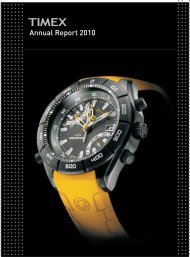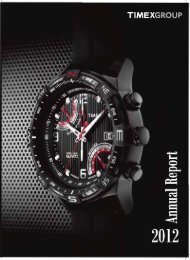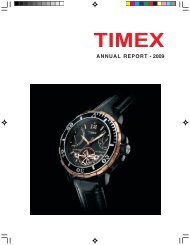Annual Report-FY 2012-13 - Timex Group India
Annual Report-FY 2012-13 - Timex Group India
Annual Report-FY 2012-13 - Timex Group India
You also want an ePaper? Increase the reach of your titles
YUMPU automatically turns print PDFs into web optimized ePapers that Google loves.
Operating cycleOperating cycle is the time between the acquisition of assets for processing and their realisation in cash or cashequivalents. Based on the criteria set out in revised schedule VI, the Company has ascertained its operating cycle beinga period within 12 months for the purposes of classification of assets and liabilities as current and non-current.d. Fixed assets and depreciationFixed assets are carried at cost of acquisition less accumulated depreciation. Cost is inclusive of freight, duties,taxes and any other directly attributable costs to bring the assets to their working condition for intended use.Depreciation on tangible assets other than leasehold land and leasehold improvements is provided under the straightline method over the useful life as estimated by the management or the derived useful life as per Schedule XIV ofthe Companies Act, 1956, whichever is lower. Depreciation on the following categories of fixed assets is providedat rates that are higher than the corresponding rates prescribed in Schedule XIV:• Plant and machinery (including office equipment) at rates ranging from 4.75% per annum to 100% per annumbased on technical evaluation.• Furniture and fixtures at the rate of 20% per annum.• Tools and moulds are fully depreciated in the year of manufacture / purchase.Depreciation on additions is provided on a pro-rata basis from the date of acquisition/installation.Depreciation on sale/deduction from fixed assets is provided for upto the date of sale/adjustment, as the case may be.Leasehold land is amortised over the period of lease.Leasehold improvements are depreciated under the straight line method over the lowest of the following:• period of the lease• useful life as estimated by managementAssets costing upto Rs. 5,000 are fully depreciated in the year of purchase.Gain or loss arising from derecognition of fixed assets are measured as the difference between the net disposalproceeds and the carrying amount of the assets and are recognised in the Statement of Profit and Loss when assetsare derecognised.e. Intangible assets and amortisationIntangible assets comprising software are carried at cost of acquisition less accumulated amortisation. Cost is inclusiveof duties, taxes and any other directly attributable costs to bring the assets to their working condition forintended use.Software is amortised over their estimated useful life of 5 years.Assets costing upto Rs. 5,000 are fully depreciated in the year of purchase.Gain or loss arising from derecognition of intangible assets are measured as the difference between the net disposalproceeds and the carrying amount of the assets and are recognised in the Statement of Profit and Loss when assetsare derecognised.f. ImpairmentThe carrying amounts of assets are reviewed at each balance sheet date in accordance with Accounting Standard– 28 on ‘Impairment of Assets’ to determine whether there is any indication of impairment. If any such indicationexists, the recoverable amount of the asset is estimated. An impairment loss is recognised whenever the carryingamount of an asset or cash generating unit exceeds its recoverable amount. Impairment losses are recognised inthe Statement of Profit and Loss. An impairment loss is reversed if there has been a change in the estimates usedto determine the recoverable amount. An impairment loss is reversed only to the extent that the asset’s carryingamount does not exceed the carrying amount that would have been determined net of depreciation or amortisation,if no impairment loss had been recognised.g. InventoriesInventories are valued at the lower of cost and net realisable value. Cost of inventories includes all costs incurredin bringing the inventories to their present location and condition.In determining the cost, the weighted average cost method is used. Fixed production overheads are allocated on thebasis of normal capacity of production facilities. Finished goods and work-in-progress include appropriate shareof allocable overheads.32





